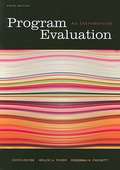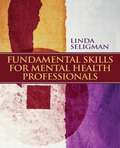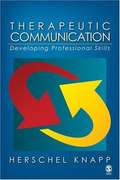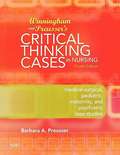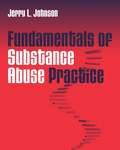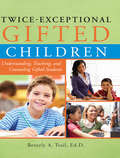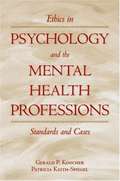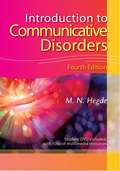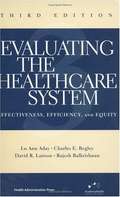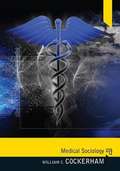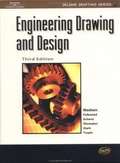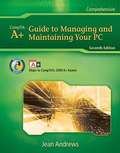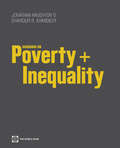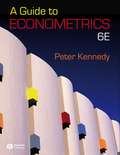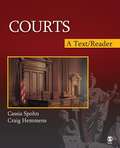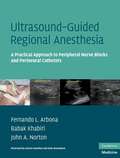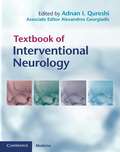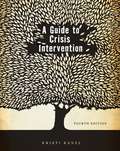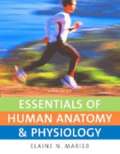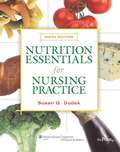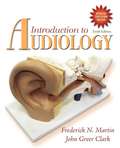- Table View
- List View
Program Evaluation: An Introduction (5th edition)
by David Royse Bruce A. Thyer Deborah K. PadgettPraised by instructors and students alike, PROGRAM EVALUATION: AN INTRODUCTION helps your students evaluate services and programs that they will encounter in their professional practice. In the process of learning evaluation techniques and skills, students will become proficient at critically analyzing evaluation studies conducted by others. The authors present and simplify all the essentials needed for a critical appreciation of evaluation issues and methodology. The authors? clear writing style and clear presentation of concepts, as well as the text's hands-on and applied focus, will guide students on how to gather evidence and demonstrate that their interventions and programs are effective in improving clients? lives.
Fundamental Skills for Mental Health Professionals
by Linda SeligmanThis book is intended to help students and novice clinicians, as well as more experienced clinicians, in the mental health professions of counseling, psychology, and social work to develop competence in the fundamental skills of their profession. With a solid grounding in such skills as effective use of questions, reflection of feelings, eliciting and modifying dysfunctional thoughts, and behavioral change strategies, clinicians can both acquire a sound understanding of their clients and develop strong helping skills.
Therapeutic Communication: Developing Professional Skills
by Herschel Knapp"The volume provides a clear and in-depth delineation of the essential therapeutic skills and techniques along with pertinent exemplars of their application." Luther Brown, Castleton University. "I think the author conveys very well what the skills are in a simple way. The way he/she writes is very appealing and clear. The examples used are good and reinforce the skill learned. I really like the discussion that helps differentiate counseling from friendship as well as the role of the counselor." Lisa Costas, Florida School of Professional Psychology, Argosy University. Written in a clear and concise style, this jargon-free text provides student clinicians with the practice principles and fundamental communication skills used to facilitate effective therapeutic communication with clients. Organized into discrete sections to highlight one skill at a time, each chapter follows a unified format including an overview of the skill (e.g., empathy, reflection, validation), rationale for use, exemplary dialogue between therapist and client demonstrating actual usage of the skill, tutorial commentary embedded in the dialogue example, dialogue debriefing, and suggestions for variations. Key Features: Delineates the multidimensional differences between social relationships and the realm of the professional clinician: Students are given direction in terms of applying standards such as boundaries, ethics, regulating self-disclosure, legal aspects, and client self-determination. Offers dialogue boxes and role-play exercises in every chapter: These resources illustrate the multiple uses of each skill and allow students to practice the skill sets presented. Discusses the process of balancing objectivity and empathy: Emotional dynamics are discussed along with transference, counter-transference, self-awareness, and termination. Provides a transcription of three 50-minute sessions: These transcripts point out which skill is being used by the therapist to demonstrate the essentials of clinical skill integration, short-term therapy, and termination. Includes Glossary of Terms: The book includes a glossary of terms to help students understand common terminology. Intended Audience: This supplemental text is designed for advanced undergraduate and graduate clinical skills courses across the human services in the fields of Counseling, Social Work, Psychology, and Nursing. It is also an excellent resource for any professional dealing with clients in a clinical fashion.
Winningham and Preusser's Critical Thinking Cases in Nursing: Medical-surgical, Pediatric, Maternity, and Psychiatric Case Studies (4th edition)
by Barbara A. PreusserThe fourth edition of this collection of case studies for nursing students and practitioners offers 148 examples that foster creative thinking skills in medical-surgical, pediatric, maternity and psychiatric situations. Preusser (family nurse practitioner, Veterans Administration Medical Center, Utah) groups these case studies according to body systems for a quicker access to vital information, and she illustrates the changes, complications and therapeutic interventions that may occur for each example. This latest edition also provides a new approach to prioritization tasks in clinical environments.
Economics: Theory Through Applications
by Russell Cooper A. Andrew JohnThis textbook, Economics: Theory Through Applications, centers around student needs and expectations through two premises: ... Students are motivated to study economics if they see that it relates to their own lives. ... Students learn best from an inductive approach, in which they are first confronted with a problem, and then led through the process of solving that problem. Many books claim to present economics in a way that is digestible for students; Russell and Andrew have truly created one from scratch. This textbook will assist you in increasing students' economic literacy both by developing their aptitude for economic thinking and by presenting key insights about economics that every educated individual should know.
Fundamentals of Substance Abuse Practice
by Jerry L. JohnsonProviding a text for undergraduate and entry-level graduate students in social work, and a resource for practitioners, Johnson shows how to gather and use multi-systemic and multi-level client data for assessing and treating substance abuse in individuals and families. Johnson, a practitioner with more than 20 years in substance abuse practice, begins with an overview of the field including prevalence of substance abuse problems and definitions of use, abuse and addiction. Additional chapters describe the effects of specific drugs, prominent theories and models for practice, methods for client engagement and communication, the influence of the community on individuals and families seeking substance abuse services, and strategies for multi-systemic treatment planning. Annotation (c)2003 Book News, Inc., Portland, OR (booknews.com)
Twice-exceptional Gifted Children: Understanding, Teaching, and Counseling Gifted Students
by Beverly A. TrailGifted students with disabilities, also referred to as twice-exceptional children, need the strategies in "Twice-Exceptional Gifted Children: Understanding, Teaching, and Counseling Gifted Students" in order to find success in the regular classroom. By offering a thorough discussion of twice-exceptional students based on research into how gifted students with disabilities learn, the author helps teachers and education professionals develop a broad understanding of the complex issues associated with gifted students who have disabilities. This comprehensive text provides an overview of who these students are, how teachers can tap into their strengths and weaknesses, and what educational strategies should be implemented to help these students succeed in school and beyond. The book will guide a collaborative team step-by-step through the process of identifying students' needs, selecting modifications and accommodations, and developing a comprehensive plan to meet the diverse needs of twice-exceptional children. By implementing the strategies suggested in this book, teachers of twice-exceptional gifted students can ensure these students do not just survive in the classroom, but thrive.
Ethics in Psychology and the Mental Health Professions: Standards and Cases (3rd edition)
by Gerald P. Koocher Patricia Keith-SpiegelWe seek to present the full range of contemporary ethical issues in the mental health professions, not only as relevant and intriguing but also as integral and unavoidable aspects of the our complex professional roles and social responsibilities. Regardless of one's training speciality or the work setting, critical dilemmas will arise -- probably with some regularity--and we will often need to make challenging decisions or take intervention steps, sometimes right on the spot.
Introduction to Communicative Disorders (4th edition)
by M. N. HegdeIn this update of the 2001, 1995, and 1991 editions, Hegde (communication sciences and disorders, California State U. , Fresno) introduces the rapidly growing science of communication and profession of communicative disorders. Coverage includes a new chapter on literacy skills in children and the role of the speech-language pathologist in literacy intervention; profiles of speech-language pathologists and audiologists; and expanded material on audiology, audiology rehabilitation, and disorders of swallowing. The text includes study questions; information on professional education, organizations, and standards; a glossary.
Evaluating the Healthcare System: Effectiveness, Efficiency, and Equity (3rd edition)
by Lu Ann Aday Charles E. Begley David R. Lairson Rajesh BalkrishnanAday and other authors from the School of Public Health and Medicine at the University of Texas introduce fundamental concepts and methods of health services research and illustrate their application to policy analysis, presenting specific examples of health services research at the national, state, and local levels. This third edition draws on a growing body of research on the social and economic determinants of population health. The primary audiences for the book are professionals and graduate students in public health, health administration, and the healthcare professions. Annotation ©2004 Book News, Inc., Portland, OR (booknews.com)
Medical Sociology (12th edition)
by William C. CockerhamFor upper-division undergraduate/beginning graduate-level courses in Medical Sociology, and for Behavioral Science courses in schools of Public Health, Medicine, Pharmacy, and Nursing. Offers a comprehensive overview of the most current issues in medical sociology. The standard text in the field, this best-selling introduction to medical sociology presents the most recent and relevant ideas, concepts, themes, issues, debates, and research findings. It contains first-person accounts from patients, physicians, and other health care providers. It is based on a worldwide review of the literature and provides the most recent health statistics, data, and studies available while identifying the most important trends and issues.
Engineering Drawing And Design (3rd edition)
by David A. MadsenReflecting the National Standards Institute and American Society of Mechanical Engineers guidelines, this textbook focuses on the development of skills like sketching, descriptive geometry, dimensioning, and pictorial drawing, and then applies them to discussions of manufacturing materials and processes. All the engineering disciplines are covered, including welding, fluid power, piping, electricity and electronics, HVAC, and sheet metal. Methods and principles for preparing technically precise engineering drawings are featured throughout.
Equine Science (2nd edition)
by Rick ParkerThis text covers the reproduction, development, training, nutrition, health, and general management of horses, with chapters on breeds and classes of horses, functional anatomy, biomechanics of movement, genetics, and selecting and judging horses. Also covered are feeds, parasite control, behavior and training, and career opportunities. Learning features include objectives, key terms, and activities, plus appendices on gestation calculations and health maintenance scheduling, and contact information for horse industry organizations and agencies. This second edition provides Internet resources. Parker is a division director at the College of Southern Idaho.
A+ Guide to Managing and Maintaining Your PC (7th edition)
by Jean AndrewsWritten by best-selling PC repair author and educator Jean Andrews, the seventh edition of A+ Guide to Managing and Maintaining Your PC maps fully to CompTIA's 2009 A+ Exam objectives. This full-color guide is the most complete, step-by-step book available for learning the fundamentals of supporting and troubleshooting computer hardware and software. At the same time, it prepares readers to successfully pass the A+ 220-701 and 220-702 exams. The new edition is formatted to support any teaching or learning style and course format, featuring an essentials-to-practical organization within each chapter and inclusion of tabs distinguishing exam content. Further content and live demonstrations with Jean Andrews are available on the accompanying CD, making this new edition a total solution for PC repair.
Information Systems: A Manager's Guide to Harnessing Technology version 1.2
by John GallaugherInformation Systems: A Manager's Guide to Harnessing Technology V1.2 is intended for use in undergraduate and/or graduate courses in Management Information Systems and Information Technology. Version 1.2 of John's book retains the same structure and theory of version 1.1, but refreshes key statistics, examples, and brings case material up to date (vital when covering firms that move as fast as Facebook, Google, and Netflix). Adopting version 1.2 guarantees your students will have the most current text on the market, drawing real and applicable lessons from material that will keep your class offerings current and accessible.
Handbook on Poverty and Inequality
by Jonathan Haughton Shahidur R. KhandkerHandbook on Poverty and Inequality was originally designed to support training courses in poverty analysis and inequality. The Handbook begins with an explanatory text that includes numerous examples, multiple-choice questions to ensure active learning, and extensive practical exercises that use Stata statistical software. The Handbook will help researchers and evaluators in charge of preparing background materials for Poverty Reducation Strategy Papers (PRSPs) and those responsible for monitoring and evaluating poverty reduction programs and policies. The World Bank Institute has used the Handbook in training workshops in countries from Bangladesh, India, and Pakistan, to Cambodia, Indonesia, the Philippines, and Thailand, to Malawi and Tanzania, as well as in university courses on poverty and in distance education courses with participants from Asian and African countries. The Handbook has also been used in an online asynchronous course with more than 200 participants worldwide. Using the feedback from these courses, the authors have created a clearly-written text that balances rigor with practicality. The Handbook is designed to be accessible to people with a university-level background in science or the social sciences. It is an invaluable tool for policy analysts, researchers, college students, and government officials working on policy issues related to poverty and inequality.
A Guide to Econometrics (6th edition)
by Peter KennedyThis book designed to illuminate the logic of econometrics without formulas, providing intuition, skepticism, insights, humor, and practical advice. Designed for use in a range of courses, from undergraduate to graduate and PhD level.
Courts: A Text/Reader
by Cassia Spohn Craig HemmensIntended for graduate and undergraduate study of the judicial system, this textbook on the United States criminal court system provides an overview of the processes, research principles and classic case studies that define this institution. Spohn (criminology and criminal justice, Arizona State U.) and Hemmens (criminal justice, Boise State U.) have made the text for accessible for students who are not necessarily studying law, and they include discussion questions, readings and exercises that focus more on the practical aspects of courts and less upon legal theory. An online site provides additional Internet resources for students, and instructors can order an additional CD-ROM that contains a test bank, PowerPoint slides and classroom activities. Annotation ©2009 Book News, Inc., Portland, OR (booknews.com)
Ultrasound-Guided Regional Anesthesia
by Babak Khabiri John A. Norton Fernando L. Arbona Charles Hamilton Kelly WarnimentRegional anesthesia is a fast-growing field, fuelled by the application of ultrasound technology over the last decade. This book is a technique-oriented guide, which introduces the use of ultrasound technology with practical instruction in the placement of peripheral nerve blocks and continuous perineural catheters. Each procedure is summarized for quick, easy reference, and supplemented by ultrasound images, color photos, and detailed illustrations. Helpful hints and instructions are provided to further optimize block success. Chapters are organized into four sections, focusing on introductory concepts, upper extremity peripheral nerve blocks, lower extremity peripheral nerve blocks and continuous perineural catheters. Written by instructors from a major academic medical center who work in a fast-paced ambulatory setting, this is a key text for residents, fellows and staff physicians who wish to incorporate the use of ultrasound into the scope of their anesthetic practice.
Textbook of Interventional Neurology
by Adnan I. Qureshi Alexandros L. Georgiadis"Endovascular intervention - using medication and devices introduced through catheters or microcatheters placed into the blood vessels through a percutaneous approach - has emerged as a relatively new minimally invasive approach to treat cerebrovascular disease and possibly intracranial neoplasms. This textbook provides a comprehensive review of principles pertinent to endovascular treatment of cerebrovascular diseases and intracranial tumors, with a detailed description of techniques for these procedures and periprocedural management strategies. Particular emphasis is placed on expert interpretation of the quality of evidence provided and implications for practice related to endovascular procedures. This will be essential reading for clinicians working in interventional neurology and cardiology, endovascular neurosurgery, vascular surgery and neuroradiology"--Provided by publisher.
A Guide to Crisis Intervention (4th edition)
by Kristi KanelWritten for beginning paraprofessional counselors, this textbook on crisis intervention outlines skills and strategies that Kanel (crisis intervention, California State U., Fullerton) found useful as a psychotherapist. She describes what can be defined as a crisis, the history of the field, ethical and professional issues, cultural sensitivity, and the ABC model of conducting mental health interviews with clients, which consists of three stages: developing and maintaining contact, identifying the problem and providing therapeutic interaction, and coping. She then outlines crises that are dangers, including suicide, self-mutilative behaviors, and psychotic breakdowns, and discusses gravely disabled mentally ill persons. Types of crises associated with stages of development, loss, AIDS and HIV, substance abuse, post-traumatic stress, disaster, and child, spousal, and sexual abuse are detailed. Indexes are divided by subject and name. Annotation ©2006 Book News, Inc., Portland, OR (booknews.com)
Essentials of Human Anatomy and Physiology (9th edition)
by Elaine N. MariebThis text introduces students to the structure and function of the human body. Marieb, an R.N. and Ph.D. who teaches at Edison Community College and Holyoke Community College, designed this book for students pursuing careers in the allied health fields but who may have limited previous exposure to the sciences. Sections discuss immunology and clinical advances based on current research, and throughout the book emphasizes career orientation through interviews with working professionals.
Nutrition Essentials for Nursing Practice (6th edition)
by Susan G. DudekThis introductory-level, nursing-focused nutrition book is meant to be introduced in the beginning of the curriculum and used as a reference in later stages of the curriculum. The text is written in a user-friendly style that incorporates the Nursing Process approach, with a heavy emphasis on patient teaching and interactive features to engage students.
Medical, Psychosocial and Vocational Aspects of Disability (3rd edition)
by Martin Brodwin Frances W. Siu John Howard Erin R. BrodwinThe text is widely used at the master's level for students in the broad field of rehabilitation counseling and allied health services. The text has become a standard in the field of rehabilitation counseling and is a useful reference for professionals involved in day-to-day case work.
Introduction to Audiology (10th edition)
by Frederick N. Martin John Greer ClarkThe ninth edition of Martin's (U. of Texas at Austin) and Clark's (U. of Cincinnati) textbook features updated material throughout the text, including more detailed discussions of recent objective measures; new material on licensing/certification, outcome measures, and evidence-based practice; a revised discussion of the rapidly evolving measures of auditory evoked potentials; and separate discussions of pediatric and adult hearing aid selection/verification and hearing loss management.
